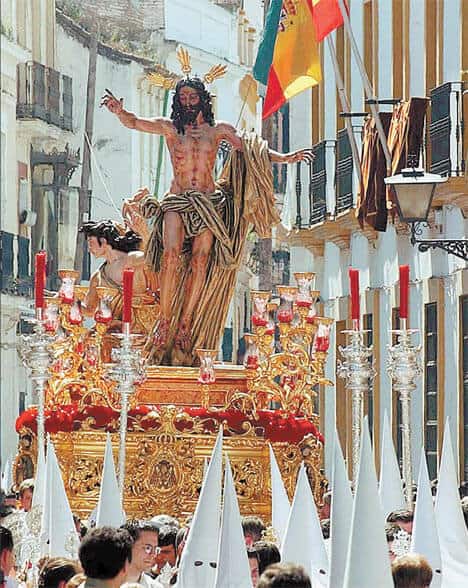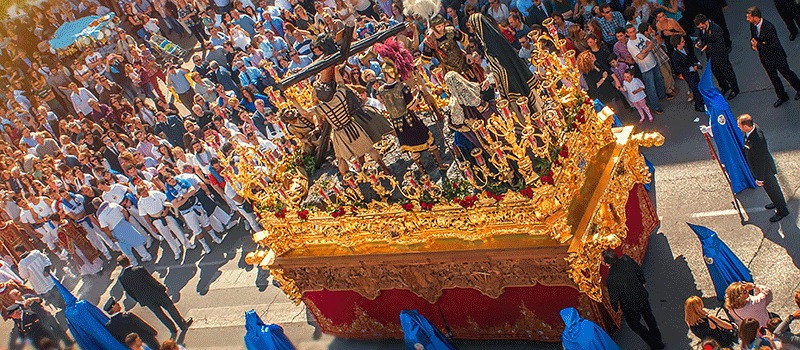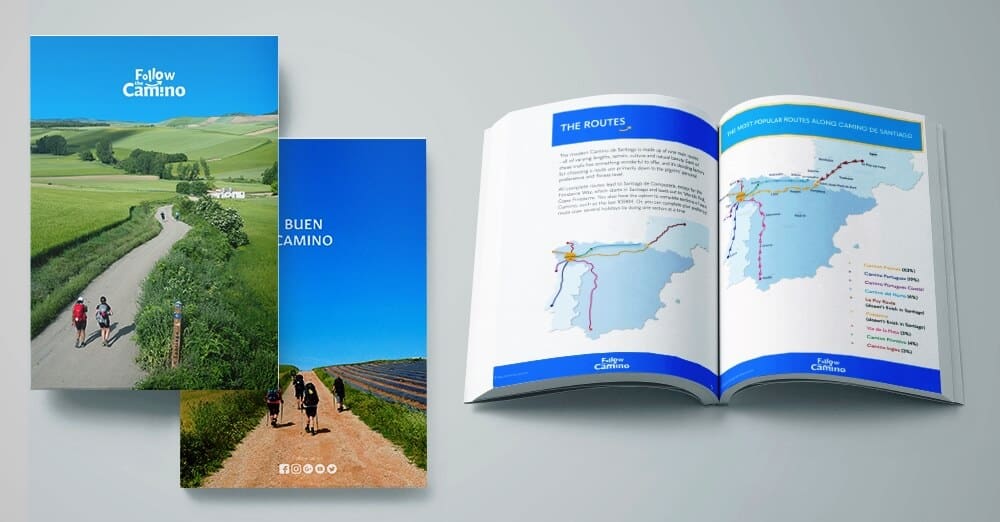Easter on the Camino is locally known as Semana Santa and it is one of the most important religious festivals in Spain. From big, bustling cities to small, quiet villages, the whole country celebrates with an ignited passion.
Huge parades take up the streets and processions march through the roads bearing religious images and symbols. People from every nook and cranny of the country observe the Holy Week in a unique way, portraying their culture, way of life, and religious beliefs. It would not be an exaggeration to say the entirety of Spain lights up brilliantly.
Easter is both a Christian and cultural festival that takes place according to a lunisolar calendar. The holiday, also known as Pascha and Resurrection Sunday, celebrates Jesus’ rising from the dead. In Spain, it begins with the Domingo de Ramos (Palm Sunday) and ends with Lunes de Pascua (Easter Monday).
While it is one thing to read about the festivities and processions of Semana Santa, or watch it online, it is an altogether different experience to attend first-hand.
If you happen to be on the Camino during Easter Week, make sure you observe the celebrations! Easter on the Camino will be a wonderful experience that will stay with you forever.
How is Spanish Easter Celebrated? Traditions, Glamour, and Food

In Spain, people participating in Semana Santa processions put on their capirote – a traditional uniform of brotherhoods worn during Easter.
This uniform consists of a tall, pointed conical hat that completely covers the face and belted robes. In previous centuries, the dress was worn by people who were paying public penance for their sins. They would slip into capirotes and walk through the streets for atonement.
Today, it is worn during the Holy Week. Women wear a mantilla, a traditional Spanish lace or silk veil worn over the head and shoulders, often paired with a high comb called a peineta.
In most Easter celebrations, people are seen carrying pasos that they have saved for hundreds of years, passed down through generations. Pasos are large floats embellished with statues of Jesus Christ, the Virgin Mary, saints, and other biblical figures. They are often adorned with floral arrangements and candles.
Holy Week in Andalusia
The southern Spanish region is known to host some of the most glamorous Easter processions and attracts tourists from all over the world. In Andalusia, particularly the cities of Seville, on the Via de la Plata Camino, and Málaga, the celebrations are carried out in flamenco style.
Spanish Easter Treats
Unlike many other countries, chocolate Easter eggs are not all that popular in Spain. However, you don’t have to worry about your sweet tooth. Spaniards have some amazing treats for Easter in store for you. There are torrijas, a traditional Semana Santa sweet bread, and Pestinos, Sesame-flavored pastries.
Easter on the Camino

Celebrating Easter on the Camino will be an experience of a lifetime. The pilgrims who happen to be walking the Way of St. James during the Holy Week of Easter will observe ancient traditions and exuberant festivities.
Even though people enjoy the celebrations in high spirits the entire week, the major events take place on the most important dates in the Easter calendar – Holy Thursday and Holy Friday (Good Friday).
In Galicia, the coastal city of Ferrol is highly renowned for its impressive processions during Easter. Ferrol happens to be the beginning point of the Camino Inglés, the English Way, a route Irish and English pilgrims used to take to reach Santiago de Compostela.
On their way along the Camino de Santiago, pilgrims can make a stop at major towns such as Santiago de Compostela, Burgos, Leon, Santander, Bilbao, and Pamplona, and witness their particular way of celebrating Easter.
Easter Week in Pamplona

Appreciate the festivities of Easter on the Camino when you are in Pamplona. This city, renowned for running the bulls, also has a great knack for celebrating the Holy Week.
Semana Santa in Pamplona has three highlights – Easter Thursday, Good Friday, and San Miguel de Aralar.
Easter Thursday – Easter Thursday dates back to 1599 when more than half the population of Pamplona succumbed to Plague. In hopes to annihilate the illness, a procession was held known as ‘the Vow of the Five Wounds’.
Legend says that after the procession, the illness of the Plague was thoroughly vanquished. Today, people don ceremonial attires and gather in the Church of San Agustín to retake the Vow.
Good Friday – Good Friday is the most symbolic day of Semana Santa in Pamplona. On this day, the Procession of the Holy Burial takes place. People carry the statue of Our Lady of Solitude, also known as “La Dolorosa”, from the Cathedral to the Church of San Agustín. On early Saturday morning, La Dolorosais is carried to the Church of San Lorenzo.
San Miguel de Aralar – San Miguel de Aralar takes place on a Monday that follows Easter Monday. On this day, the figurine of Saint Michael Archangel is brought to the city for one week.
To welcome the arrival of the effigy, the locals gather together at the Park of Antoniutti. After the figurine has arrived, people carry it to the Church of San Nicolás where it is worshipped. When Sunday comes, the people of Pamplona bid goodbye to the effigy until the next year.
Easter Procession in Bilbao
Easter processions that march through the roads of Bilbao begin at the church of the Santos Juanes. The church, located in an old quarter of Bilbao, is the head office of the Brotherhood of the Santa Vera Cruz.
Santa Vera Cruz, also known as the Sacred Holy Cross, is a well-known procession in Bilbao that has been taking place since 1554 to honour the memory of those who passed away in the great flood that destroyed Bilbao on September 14, 1553.
Moreover, you will see “pasos” of important historical and religious figures. About 40 kilometres away from Bilbao, the living Vía Crucis pageant is held which is one of the most important highlights of the Holy Week.
Holy Week on the Camino – Santiago de Compostela
On your pilgrimage during the Holy Week, you will come across plenty of festive celebrations. If you happen to be on the Camino de Santiago, don’t hesitate to join the spirited adventure of Easter on the Camino and participate in the jolly celebrations.
In Santiago de Compostela, some of the Easter processions take place at nighttime where all the streets are lit by candles and torchlight. The unique medieval experience is not only beautiful to look at but has a great sense of spirituality too.
It doesn’t matter whether you are on Camino for the religious walk or on a hiking trip; the whole week of Easter on the Camino is filled with impressive sights that will leave you in awe.
Don’t forget to check out What if Santa walked on the Camino for even better holidays!




-260x260.png)
-260x260.png)

